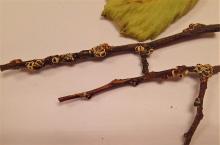Gossyparia spuria
The European elm scale is a reddish-brown to purplish scale surrounded by a conspicuous fringe of white, waxy material. They sometimes resemble mealybugs. The mature females are about 0.125 inch in diameter. The crawlers emerge in late spring and summer and are yellowish to dark brown. The scale feed on twigs and branches as well as leaves. Feeding scale produce honeydew, a sweet, sticky material which attracts honeydew-feeding ants and may become covered with a growth of black sooty mold. Infested trees may show yellowing leaves and early leaf drop, followed by death of twigs and branches. Severe infestations may cause extensive damage.
Biology and life history The scale overwinter as immature crawlers in bark crevices of small branches and branch crotches. In spring, the females lay eggs, and crawlers are active by June. They move to the undersides of leaves to feed, remaining there all summer. Often, the scale drop to the ground with the normal leaf-fall and are killed. There is one generation per year.
Management-cultural control
Asiatic elms such as Chinese elm (U. parvifolia) apparently are not infested. Siberian elm (U. pumila) is also resistant but is a poor shade tree. Provide proper culture to maintain plant health. Healthy trees are more able to tolerate scale infestations. Prune and destroy twigs to help control isolated infestations, when practical.
For more information
Johnson, W.T. and H.H. Lyon (1991), Insects That Feed on Trees and Shrubs, 2nd ed., Cornell University Press (p. 368).




